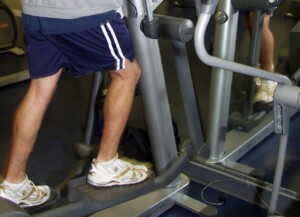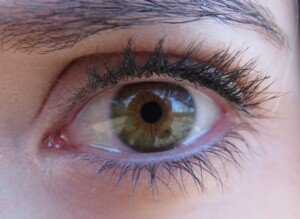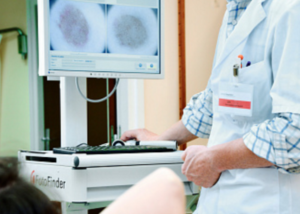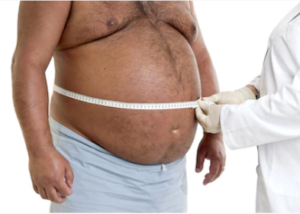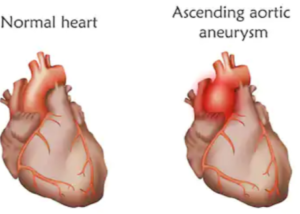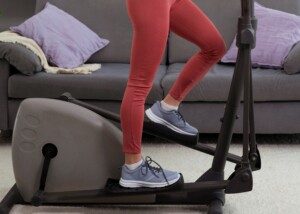Safe Summer Hiking Preparation for Obese People

Obese people can begin their hiking preparation safely inside a gym or even their home, but if they want to venture outdoors from the start, that’s fine too. (more…)
Should You Hold onto a MANUAL Treadmill?

If you like using a manual (foot powered) treadmill but hold onto the rails, this is very wrong and defeats the purpose of this kind of machine.
Holding on cancels out or undoes the benefit of the foot-powered apparatus.
As a former personal trainer, I was inspired to write this article after seeing a woman “walking” on a manual treadmill at a fast speed.
Her hands were clutching the side rails at every moment, arms stiffly bent and tense, shoulders locked up, posture skewered. This is not the right way to walk.
She was actually slightly leaning over to one side, one arm more bent.
Her upper body was locked in this crooked position while her legs “walked” on the manually powered belt.
In short, her holding onto this manual treadmill was wrecking her posture through-and-through.
She was wasting her time. I just could not believe what I was seeing.
What is the point of using a foot-powered treadmill when you’re going to clutch the rails?
Every so often she intentionally jerked in an attempt to get more out of the “walking,” pulling harder on the hand rails with each step.
By the way, it was easy for me to observe her because I just happened to be working out at a station that was facing her about 30 feet away.
I thought, “If you want to up the ante of your walking, take your hands off the rails!”
Manual Treadmill: Why You Should Not Hold Onto the Rails

Pexels/Anastasia-shuraeva
If you’re not holding on, the muscles in your legs and glutes are doing all of the work. YOUR CORE IS ALSO VERY INVOLVED.

It’s easy to see that the walker’s core is getting a free ride as she grips the side rails. Letting go will force her body to improve balance. If she goes slowly enough, she will NOT fall off. Shutterstock/wavebreakmedia
Leg muscles burn more calories than arm muscles. So if burning calories is important to you, do not hold onto the rails.
Ignore the calorie display: This is triggered by the speed, not the person using the apparatus.
What if you don’t care about calories burned?
If you don’t care and are focused more on a cardio and fitness workout, then again, do not hold on. This messes up posture and creates a false sense of “I had a good workout.”
“The same rules should apply to both manual and motorized treadmills when it comes to holding on,” begins Dr. Tom Carpenter, corrective exercise specialist, certified personal trainer and chiropractor, inventor of Stand Corrected™, a portable harness-like stretching tool that helps alleviate back, neck and shoulder pain.
Dr. Carpenter continues, “Being hands free will engage the entire core and kinetic chain, enabling the body to recruit all of its posture and balancing muscles.
“Although there are other pros and cons to motorized versus manual treadmills, letting go of the rails is important when using either one.”
Let Go of the Manual Treadmill and Feel the Difference
If you walk without holding onto the manual treadmill, you’ll instantly feel a big difference: Your feet are truly powering the tread, rather than just gliding through the motions.
Don’t think for a moment that just because the treadmill is powered by your feet, that it’s okay to hold on.
- It’s not.
- This is cheating.
- It’s not real walking, even though there’s no electric motor.
- Your hand placement on the rails, especially a solid grip, subtracts significant workload from your legs, hips and feet!
Fear of Falling off a Manual Treadmill
• Walk slowly at first. The woman I saw was charging along and perhaps felt that if she let go she’d get thrown off.
• Walk SLOWLY. And just stay at that slow pace, without holding on, until you feel in control.
• Then gradually move faster. This is a manual treadmill, not a tight rope.
Walking on a manual treadmill without holding on will force your core muscle group to work!
It will force good posture! It will strengthen your ankles and calves. Need I say more?
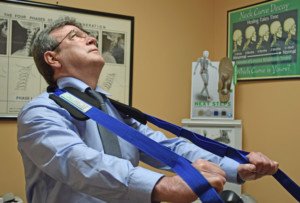
Photo credit: Aleesia Forni
Based upon 30+ years of experience, Dr. Carpenter’s practice approach reflects his belief that restoring optimum health and function will enable his patients to enjoy a much greater amount of vitality and wellness. Chiropractic care is true health care, not sick care!
 Lorra Garrick has been covering medical, fitness and cybersecurity topics for many years, having written thousands of articles for print magazines and websites, including as a ghostwriter. She’s also a former ACE-certified personal trainer.
Lorra Garrick has been covering medical, fitness and cybersecurity topics for many years, having written thousands of articles for print magazines and websites, including as a ghostwriter. She’s also a former ACE-certified personal trainer.
.
Top image: Shutterstock/Piyawat Pansirimongkonkun
How to Deadlift with Long Femurs to Shin Ratio

A person of any height can have disproportionately long femurs.
The long femur problem is not a function of overall body height.
It’s about femur length relative to torso and shin length.
My femur length seems to be a few inches longer than my torso, but what’s more striking is that my shin bones should be longer, relative to my femurs.
These proportions put me at a biomechanical disadvantage with the deadlift, especially since my arm span is only equal to my height or maybe one-half inch more at most, though I haven’t had this formally measured.
Let’s put it this way: The length of my arms certainly serve no advantage in the bench press.
I can pull 245 x 4 (I’m a woman), and I never use straps, gloves or chalk.
Why Long Femurs Interfere with Efficient Deadlift Form
It’s simple: Long femurs (again, relative to torso and especially shin length, regardless of height) force your hips further behind the barbell.
This forces you to lean forward more to reach the barbell, placing your back in a stressful position — which for some people, is nearly parallel to the floor in the start position of the pull.

With your hips sitting way back, you just have no choice but to compensate by leaning forward more to get your hands to the bar.
If you have wickedly long arms along with the lengthy femurs, you won’t need to lean forward as far to reach the bar.
How to Deadlift with Long Femurs and Short Shins
Some people swear by the Sumo style. Others endorse a variation of the conventional style: wider foot placement, but not as wide as Sumo.
Some suggest turning out the feet with the standard style, to trick the body into thinking the femurs are shorter.
I’ve studied my profile in a mirror, experimenting with these variations.
If my feet are wide but not Sumo, there’s pretty much zero difference in the “uprightness” of my back.
If I pull Sumo, my back is only a little bit more upright, and it’s very awkward on my hips.
Due to the long femurs, Sumo forces a lot of engagement of the hamstring-glute tie-in. Not pretty.

Sumo style deadlift may work well for some people with long femurs. Shutterstock/ Oleksandr Zamuruiev
Turning my feet out doesn’t change anything, either. So my advice is to find the form that you feel most comfortable with.
For me, my feet are close together. I have the most power and comfort this way. My hands are close together, just inside my knees.
The irony is that few people deadlift this way, and would probably find it difficult. But my body feels as though it’s in its strongest position this way.
Tweaking Deadlift Form with Long Femurs (and Short Shins)

If your shins are short relative to your femurs, keep reading! Freepik.com
Learn how to tolerate the barbell rolling up along your shins.
You’re already leaning out further than you should be, due to the long femurs forcing your hips way behind the bar, but you have no choice.
And the only way to offset this (which isn’t much) is to roll that bar along your shins, so that you’re not leaning forward any further than you absolutely have to.
My shins sometimes have mild bruises on them. I have perfected this roll so that it’s not klutzy or uncontrolled.
Your shins will have to be covered with sweats, leggings or socks.
- Next, no matter what you do, keep your shoulders above hip level.
- Do not round your back.
- Fight to keep the lumbar area slightly arched. Just fight for this.
Concentrate on driving upward with leg power while your lower spine is stabilized.
Make sure your knees don’t buckle or cave inward as you pull.
Are there any exercises that will help with the deadlift?
I do not improve with the deadlift by doing rack pulls, “deficit” deadlifts, hex bar (trap bar) pulls or dumbbell deadlifts.

Hex deadlift
However, you should try these because what doesn’t work for one person may be a godsend to another.
Getting stronger in the back squat should help — but that’s probably not what people with long femurs and short shins want to hear.
One sure way to get better with the deadlift is to keep training in this movement.
What if you have T-rex arms along with those long femurs?
There’s not much more you can do than to follow the guidelines here and also consider hiring a powerlifting coach.
Other Factors that Influence Efficiency with the Deadlift
Ratio of fast twitch fiber to slow twitch, integrity of spine, tendon insertion length, grip strength and size of hands.
If you have long femurs and especially short shins, you can still learn to do a pretty good deadlift.
Just never get into the habit of rounding your back.
 Lorra Garrick is a former personal trainer certified through the American Council on Exercise. At Bally Total Fitness she trained women and men of all ages for fat loss, muscle building, fitness and improved health.
Lorra Garrick is a former personal trainer certified through the American Council on Exercise. At Bally Total Fitness she trained women and men of all ages for fat loss, muscle building, fitness and improved health.
.
Top image: Shutterstock/Maridav
Sudden-Onset One-Eye Epiphora: Possible Causes
If you have sudden-onset one-eye epiphora, don’t panic, as this may pass after only several days like a light being switched off.
“Epiphora can be from either an occlusion somewhere along the nasolacrimal passageway (easy to test for in the office) or acute dry eye,” says Yuna Rapoport, MD, a board certified ophthalmologist with Manhattan Eye in NYC.
An occlusion is a blockage. The nasolacrimal passageway is the drainage system that links the sinus area to the eyes — which is why the nose runs when people cry.
One evening I became aware that there was moisture collecting on the skin below my inner right eye.
Next day the eye was persistently welled up, and produced three or four full-fledged, clear tears rolling down my cheek during the day.
In between those tears, the eye was in a state of persistent excess wateryness.
There were no other symptoms and no recent history of trauma.
Dry eye can cause excess tearing because the dryness stimulates the tear ducts to overcompensate.
I suspected dry eye and gave it a lot of artificial tears, but it continued to be welled up.
Next day, it produced more tears rolling down my cheek. Next day, even more. Next day, in the morning, it was on course for producing even more tears.
This unilateral epiphora (which means one eye tears or is excessively watery) was building up by the day.
Causes of Sudden Epiphora in One Eye
“Sudden-onset epiphora could be from an acute infection in the nasolacrimal system, from a physical obstruction (like a stone, a punctal plug, foreign body), or from dry eye/surface disease,” says Dr. Rapoport.
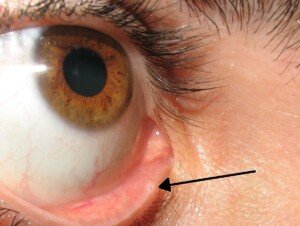
The punctum, where debris could cause an obstruction. Diogo Melo Rocha/CC BY 2.5
Other possible causes: nasal polyp, corneal abrasion and an inverted eyelash.
Can cancer cause an eye to suddenly tear excessively?
“Cancer would be the last item on my differential diagnosis,” says Dr. Rapoport.
There are many more causes for a gradual onset of an excessively watery eye, vs. a suddenly watery eye.
To be fair, it’ll be pointed out that malignant and benign tumors in the sinuses can cause a gradual onset of epiphora in one eye.
A cancerous obstruction in the nasolacrimal drainage system, too, can trigger excessive tearing in one eye. But again, this would be gradual rather than sudden appearance of tear drops rolling down the cheek.
Paranasal cancer is very rare, and malignant tumors in the lacrimal system are EXTREMELY rare.
On that fifth day in the morning, I made an appointment to see a general practitioner.
The sensation of the welling up in the right eye, prior to leaving for the appointment, seemed to be disappearing, but I figured that was just its occasional remittent nature over the past several days.
But as I waited in the doctor’s office, I was realizing that the eye didn’t feel welled-up at all. There had been no tearing since I had made the appointment.
The doctor couldn’t tell me what was wrong, but she also didn’t think it was an infection.
This sudden one-eye epiphora was simply GONE and never returned.
Eventually I asked an optometrist whom I’d spoken to previously about eyedrops for an unrelated matter what could have caused it.
He said: “a partial obstruction of the punctum.”
The puncta are the holes in the eyelid that drain tears.
“A little strand of mucus further down in the canal, not necessarily at the surface, and it kind of worked its way through,” he said, when I told him that the condition had magically shut off without tapering.
As for corneal abrasion, he said, “Generally you’re going to have some discomfort in the eye, but if it was a very small abrasion, that could cause a little bit of reflex tearing.”
Reassurance: Absence of Other Symptoms
There’s no need to panic if one eye suddenly starts watering with no other symptoms.
Concerning symptoms include vision problems (other than the blurriness caused by the excess water), a bulging eye, nearby swelling, numbness below the eye or near the nose, a stuffy feeling in the nose, nasal discharge and ear pain.
Nevertheless, if epiphora in one eye fails to clear up, you should see an ophthalmologist — even if your medical plan requires that you first see your primary care physician.

Yuna Rapoport, MD
Manhattan Eye uses state of the art LASIK technology and modern techniques for a safer and more precise correction surgery, and also provides services covering all aspects of eye health.
 Lorra Garrick has been covering medical, fitness and cybersecurity topics for many years, having written thousands of articles for print magazines and websites, including as a ghostwriter. She’s also a former ACE-certified personal trainer.
Lorra Garrick has been covering medical, fitness and cybersecurity topics for many years, having written thousands of articles for print magazines and websites, including as a ghostwriter. She’s also a former ACE-certified personal trainer.
Six Gym Behaviors that Seem Like Bullying but Are Not

Before you feel that you’ve been bullied at the gym, consider that the “bully” really isn’t, and that there’s just some misinterpretation going on. (more…)
Digital Dermoscopy: Mole Looks Very Different from Last Image
What happens when the latest mole image looks strikingly different than last year’s picture in a serial digital dermoscopy procedure?
I’ve been taking advantage of the technology of serial digital dermoscopy since 2011.
Recently an image taken of one of my moles (the “No. 2” mole) looked strikingly different from the image of it taken in 2011.
I discovered this when I was left alone in the dermoscopy room after the nurse photographed all of my moles.
I was told that the doctor was behind schedule and would be seeing me about the new images in about 20 minutes.
The nurse had left two large images up on the computer screen: No. 2 as it appeared in 2011, and how the mole looked just minutes ago after she had imaged it.
The image she had taken looked de-evolved; much less pigment, as though the mole was in the process of disintegrating.
It didn’t even have the same shape as the one depicted in the 2011 image.
At the bottom of the screen were six tiny images of “No. 2,” beginning with 2011 going through to 2016.
The first five images looked the same—but then that last image…it didn’t even look like the same mole.
How could it have been the same year after year, then suddenly between 2015 and 2016 undergo such a dramatic change?
The doctor came in and explained that the mole looked normal despite the de-evolvement. The reason it looked as it did was because, like many moles eventually, it was beginning to disappear.
She said this is why you don’t see a lot of moles on elderly people.
She pointed out something called melanophages in the 2011 image: tiny darker specks in the mole that indicated it was a relatively new mole back then.
She said that the mole probably first came into existence in around 2006. But that now, it was on its way out.
I found two things odd about this.
First, how is it that a mole begins to disappear after being in existence for only 10 or 11 years?
Second, how is it that it shows no signs of being “on its way out” in the 2011-12-13-14 and ’15 images, but then between 2015 and 2016, it rapidly begins the process of vanishing?
Right before I was about to ask her these questions, the computer screen went out; the doctor had to leave to get a nurse to reset it.
I waited quite a while, quite unnerved. I wondered if the nurse had accidentally photographed the wrong spot.
Turns out she did! The image was retaken, and the right mole was now on the screen, and the “mole analysis” gave it two scores in the normal range.
Lesson learned: If the latest image of a mole in your serial digital dermoscopy exam looks a lot different than the one taken at the previous exam, make sure it was the RIGHT mole that was photographed in the first place.
Whomever is taking the pictures is human and thus, subject to error and getting things mixed up.
Serial digital dermoscopy is an outstanding technology that uses a computer database to rate moles with a numerical value to indicate if they are in a normal range or “suspicious.”
 Lorra Garrick has been covering medical, fitness and cybersecurity topics for many years, having written thousands of articles for print magazines and websites, including as a ghostwriter. She’s also a former ACE-certified personal trainer.
Lorra Garrick has been covering medical, fitness and cybersecurity topics for many years, having written thousands of articles for print magazines and websites, including as a ghostwriter. She’s also a former ACE-certified personal trainer.
.
Top image: cancer.gov
Thin and Active Is Healthier than Fat and Active
 Skinny active beats fat active hands-down. Oddly, the comparison typically is sedentary-thin vs. fat-active.
Skinny active beats fat active hands-down. Oddly, the comparison typically is sedentary-thin vs. fat-active.
This isn’t a fair comparison; it’s an apples to oranges comparison. (more…)
Does Ear Protection for Loud Noise Really Prevent Hearing Loss?

So just how effective IS protection (ear plugs, muffs) against hearing loss to loud noise?
People need to take seriously the idea of protecting their ears from hearing loss as vigilantly as they protect other functions of their body from damage.
“One of the easiest ways to reduce your risk for permanent hearing damage is to wear hearing protection at loud events and locations,” says Rivka Strom, AuD, CCC-A, chief audiologist at Central Hearing LLC in NY.
“While the intensity and duration of the sound is ultimately going to determine the amount of damage, the type of hearing protection you use can greatly reduce this risk!” explains Strom.
One in 10 Americans have enough hearing loss to disrupt their ability to decipher normal speech, and this statistic is not taken only from senior citizens.
Young adults are included.
Hearing loss is far more prevalent than most people realize, and one reason is because the symptoms of hearing loss are not like symptoms of other medical conditions.
Do you know the eight symptoms of hearing loss?
- “Honey, what was that?”
- “Come again?”
- “What?”
- “Talk louder; there’s too much noise in the room.”
- “Why do men mumble when they talk?”
- “She runs her words together; I can’t understand her.”
- “Kids these days don’t know how to speak clearly.”
- “Today’s TV shows have such poor sound quality.”
Denial is huge in the world of hearing loss.
Though aging is the most common cause of hearing loss, noise-induced loss is a very close second leading cause.
But hearing loss due to loud noise is preventable.
Hearing Protection: How Effective It Really Is
“Starting with traditional disposable earplugs [available at retailers], how much benefit you receive will depend on how well they are placed in the ear.
“Poorly secured or shallow insertion of earplugs may only give you 15 dB of noise reduction.
“A well-placed earplug that is sitting deep in the ear can provide up to 33 dB reduction.
“Earmuffs or over-the-ear ear protection may provide up to 25 dB noise reduction.” Some hunting supply sections may sell heavier-duty muffs that can go up to 29 dB.

“Custom ear protection, that is shaped exactly to your ear, may also provide up to 30 dB noise reduction,” continues Strom.
“For musicians who are worried about dangerous noise exposure, there are special filters that can be put in so they are able to hear the music clearly but at less damaging levels.”
What happens inside the ear when noise gets too loud?
The hair or nerve cells inside the ear become damaged and die.
New nerve cells to replace them do NOT exist. These nerve cells are not like skin cells that are continuously replenishing themselves.
It’s a set amount of nerve cells. If you lose any, you’re not getting them back.
You’ll never regret using ear protection in loud environments to protect yourself from hearing loss.

Dr. Strom is a member of the American Speech Language and Hearing Association and has received several awards including Brooklyn College’s Excellence In Audiology Award.
 Lorra Garrick has been covering medical, fitness and cybersecurity topics for many years, having written thousands of articles for print magazines and websites, including as a ghostwriter. She’s also a former ACE-certified personal trainer.
Lorra Garrick has been covering medical, fitness and cybersecurity topics for many years, having written thousands of articles for print magazines and websites, including as a ghostwriter. She’s also a former ACE-certified personal trainer.
Source: sciencedaily.com/releases/2012/06/120625162911.htm
Muscle-Building Chest Workout: Tension Tubes (Resistance Bands)
Don’t underestimate the efficiency of tension bands for getting in a great chest workout in which you can actually build lean muscle mass and strength. (more…)
Fun Backward Pedaling Variations on the Elliptical Trainer
